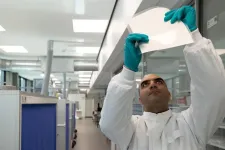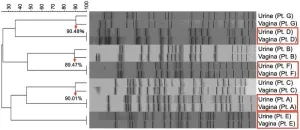(Press-News.org) By Leah Shaffer
Amyloid-beta (A-beta) aggregates are tangles of proteins most notably associated with neurodegenerative diseases like Alzheimer’s. Despite its constant stint in the limelight, however, researchers have been unable to get a good understanding of how A-beta comes together and breaks apart.
“The way A-beta behaves in a variety of environments, including the human brain, is elusive,” said Brian Sun, an electrical systems and engineering alumnus of Washington University in St. Louis who is now an MD/PhD student in the School of Medicine.
“There’s an understanding of growth and decay that isn’t fully fleshed out,” he added.
That’s going to change, thanks to research recently published by Sun with colleagues in Associate Professor Matthew Lew’s lab at the Preston M. Green Department of Electrical and Systems Engineering (ESE) in WashU’s McKelvey School of Engineering. .
In first of its kind work, Sun and colleagues were able to make measurements of amyloid fibril beta-sheet assemblies, the underlying girders of the protein conglomeration, while they were changing. Previous high-resolution microscopy studies have only gotten static shots.
“We wanted to look specifically at dynamics of the underlying structure of A-beta that could be responsible for the changes we’re seeing, not just changes in the overall shape,” Sun said.
Lew uses Lego as an analogy, noting that current imaging technology shows you the full Lego building but not any look at how each individual brick is organized.
“The individual proteins are always changing in response to their environment,” Lew said. “It is like having certain Lego bricks causing other bricks to change their shape. The changing architecture of the proteins and the assembled aggregates together leads to the complexity of neurogenerative disease.”
The Lew lab has developed a new type of imaging tech that allows them to see the orientation and other minute details in nanostructures of biological systems that were previously invisible. Their technique — single-molecule orientation–localization microscopy (SMOLM) — uses the flashes of light from chemical probes to visualize the sheets of peptides underlying Aβ42, one kind of A-beta peptide.
Using SMOLM lets them look at individual orientation of the underlying beta-sheets to see the relationship between their organization and how that relates to the overall structure of the amyloid protein.
Multiple ways to remodel
Aβ42 is constantly changing, and step one is to try to find a method to the madness, a model or pattern of action to predict the protein’s behavior.
Now that the Lew lab can make these measurements, they made some intuitive observations and found some surprises hidden in the amyloid-beta architecture.
As can be expected, stable Aβ42 structures tend to retain stable underlying beta-sheets; growing structures have underlying beta-sheets that become more defined and rigid as the growth continues. Decaying structures exhibit increasingly disordered and less rigid beta-sheets. But they also found more than one way that Aβ42 can renovate.
“There are multiple different ways for Aβ42 structures to remain stable, or grow and decay,” Sun said.
The researchers also discovered that Aβ42 can grow and decay in ways that defy expectations. For example, Aβ42 can grow and decay in ways that preserve the underlying structure; sometimes there’s growth where the peptides just pile on, but the underlying beta-sheet orientations don’t change. In other cases, Aβ42 undergoes “stable decay,” where the opposite happens, i.e., peptides leave, but beta-sheet structure remains. Finally, Aβ42’s beta-sheets sometimes reorganize and change orientations without immediate accompanying changes to the overall shape. These nano-structural reorganizations can predispose to future large-scale remodeling.
“Because SMOLM can track Aβ42’s underlying organization and not just its shape, we can see different kinds of subtypes of remodeling that aren’t visible to diffraction-limited, non-orientation imaging modalities,” Sun said.
If it all sounds a bit vague, keep in mind this is the first pass at even looking at these constantly shifting nanoscale structures. There were no previous works to compare notes, which makes it all the more notable that Sun crafted this work while juggling COVID-19 lockdown restrictions and his undergrad course load at WashU, which he completed in three years. It paves the way for him and others to start really getting a handle on amyloid architecture.
He'll likely end up chasing more of these questions during the graduate phase of his MD/PhD training, where he plans to design nanoscale imaging systems and sensors that could reveal hidden mechanisms of difficult-to-treat diseases.
Sun credits WashU ESE department and the Lew lab for the rigorous training that made this study and academic trajectory possible, as well as WashU’s MSTP for supporting his continued research post-graduation. “I’m really glad I went through this journey,” he said.
Sun B, Ding T, Zhou W, Porter TS, Lew MD. Single-Molecule Orientation Imaging Reveals the Nano-Architecture of Amyloid Fibrils Undergoing Growth and Decay. Nano Lett. 2024, 24, 24, 7276–7283. DOI: https://doi.org/10.1021/acs.nanolett.4c01263.
Research reported in this publication was supported by the National Institute of General Medical Sciences of the National Institutes of Health under Award Number R35GM124858.
END
Wash U researchers shine light on amyloid architecture
Lew lab’s innovative microscopy charts amyloid beta’s underlying structure could yield insight into neurodegenerative disease.
2024-07-19
ELSE PRESS RELEASES FROM THIS DATE:
New dawn for space storm alerts could help shield Earth's tech
2024-07-19
New dawn for space storm alerts could help shield Earth's tech
Royal Astronomical Society press release
RAS PR 24/22 (NAM 8)
For immediate release
Space storms could soon be forecasted with greater accuracy than ever before thanks to a big leap forward in our understanding of exactly when a violent solar eruption may hit Earth.
Scientists say it is now possible to predict the precise speed a coronal mass ejection (CME) is travelling at and when it will smash into our planet – even before it has fully erupted from ...
Tomorrow’s super battery for electric cars is made of rock
2024-07-19
In 10 years, solid-state batteries made from rock silicates will be an environmentally friendly, more efficient and safer alternative to the lithium-ion batteries we use today. Researcher at DTU have patented a new superionic material based on potassium silicate - a mineral that can be extracted from ordinary rocks.
It is the battery in your electric car that determines how far you can drive on one charge and how quickly you can re-charge. However, the lithium-ion battery, the most widely used electric car battery today, has its limitations— in terms of capacity, safety and also availability. ...
Fecal immunochemical test screening and risk of colorectal cancer death
2024-07-19
About The Study: In this nested case-control study, completing fecal immunochemical test was associated with a lower risk of overall death from colorectal cancer, particularly in the left colon, and the associations were observed across racial and ethnic groups. These findings support the use of fecal immunochemical test in population-based screening strategies.
Corresponding Author: To contact the corresponding author, Chyke A. Doubeni, M.D., M.P.H., email chyke.doubeni@osumc.edu.
To access the embargoed ...
Long-term use of oral corticosteroids and safety outcomes for patients with atopic dermatitis
2024-07-19
About The Study: Oral corticosteroid use of more than 90 days per year among individuals with atopic dermatitis was associated with a small increased risk of composite adverse outcomes in this large population-based case-control study. Future investigations are warranted to confirm this potential risk of adverse events (AEs) associated with long-term use of oral corticosteroids for patients with exacerbations of atopic dermatitis, and health care professionals should thoroughly weigh the benefits associated with oral corticosteroids ...
Diagnosing solid lesions in the pancreas with multimodal AI
2024-07-19
About The Study: In this randomized crossover trial of diagnosing solid lesions in the pancreas with or without artificial intelligence (AI) assistance, the joint-AI model demonstrated positive human-AI interaction, which suggested its potential to facilitate a clinical diagnosis. Nevertheless, future randomized clinical trials are warranted.
Corresponding Authors: To contact the corresponding authors, email Aiming Yang, M.D. (yangaiming@medmail.com.cn) and Bin Cheng, M.D. (b.cheng@tjh.tjmu.edu.cn).
To access the embargoed study: Visit our For The Media website at this link https://media.jamanetwork.com/
(doi:10.1001/jamanetworkopen.2024.22454)
Editor’s ...
Trillions lost in worker productivity due to eco anxiety and ‘lie-back’ lifestyles
2024-07-19
Could nature and climate anxieties predict future social behaviours, in the same way that consumer sentiment predicts purchasing and investment?
The suggestion is made in the Cell Press journal One Earth, by Griffith University’s Professor Emeritus Ralf Buckley, in a preview of an article led by Professor Thomas Pienkowski in the UK.
Professor Buckley said the international Global Burden of Disease Study had shown that anxiety and depression were widespread and worsening.
“Economic costs are up to 16% of global GDP, with 19 days per year on average lost ...
University of Cincinnati study examines impact of incarceration on youth health
2024-07-19
Researcher Samantha Boch has studied the impact of incarceration on child and family health for more than a decade.
Her latest research examines the health records and health care use of youth, individuals under age 21, who likely have been involved or whose families have been involved in the justice system. The challenge was identifying youth who have been impacted by mass incarceration, as most health care systems don’t routinely ask about incarceration. Families may not disclose that information due to stigma, fear of child protective services involvement, ...
Wetland wonders unfold: Aerial systems shed light on ecosystem services
2024-07-19
A cutting-edge study revolutionizes coastal wetland mapping by integrating unmanned aerial systems with light detection and ranging (LiDAR) and multispectral sensors. This innovative approach provides detailed elevation data and vegetation analysis, enabling highly accurate classifications of diverse wetland types. The research advances conservation by offering a scalable, efficient, and cost-effective method that is instrumental in climate change mitigation strategies and informs policy-making for coastal resilience.
Coastal wetlands, situated at the junction of land and water, are vital ecosystems known for their high productivity. They play a key role in carbon ...
New discovery adds to story of ancient human migration
2024-07-19
New evidence of human occupation in southeast Indonesia dating back 42,000 years offers fresh clues on the route taken by some of the first humans to arrive in our region, according to a study from The Australian National University (ANU).
Lead author and ANU PhD candidate Hendri Kaharudin said the location of the discovery -- at Elivavan on Indonesia’s Tanimbar islands -- makes it especially significant.
“Tanimbar is located just off the ‘Sahul shelf’, which encompasses modern-day Australia, as well as New Guinea,” he said.
“The question ...
A tale of two “niches”: The microbial connection between urinary bladder and vagina
2024-07-19
The human body hosts a diverse array of microorganisms that maintain a delicate balance crucial for overall health. This microbial harmony can be disrupted by factors like infections, aging, and hormonal changes, leading to dysbiosis—a condition where microbial communities become imbalanced and harmful to health. Postmenopausal women, for instance, are particularly susceptible to recurrent urinary tract infections and inflammation, including cystitis, due to these microbial shifts.
Dr. Takanori Sekito from the Department of Urology, Okayama University Graduate School of Medicine, Japan explains, “In postmenopausal women, the vaginal flora changes ...
LAST 30 PRESS RELEASES:
Itaconate modifications: mechanisms and applications
Potential tumor-suppressing gene identified in pancreatic cancer
Winners of the 2026 Hill Prizes announced
Autonomous AI agents developed to detect early signs of cognitive decline
Study finds ocean impacts nearly double economic cost of climate change
Increased deciduous tree dominance reduces wildfire carbon losses in boreal forests
Researchers discover how a respiratory bacterium obtains essential lipids from the human body and targets fat-rich tissues
Locust swarms destroy crops. Scientists found a way to stop that
More resources and collaboration needed to support prevention and treatment of obesity
Two types of underconfidence linked to anxiety and gender
Insects are victims too: Global study shows impacts of invasive alien species on populations
Pioneering natural, degradable polymer capsules
Forestry is becoming digital and automated
Maternity baby deaths much higher in northern England than in the South
Mosquitoes’ thirst for human blood has increased as biodiversity loss worsens
The stop-smoking medication varenicline may also work for cannabis use disorder
Potential new treatment for sepsis
Study reveals how many hours of video games per week might be too many
Electrospinning for mimicking bioelectric microenvironment in tissue regeneration
Home fingertip oxygen monitors less accurate for people with darker skin tones
Six weeks in a cast no less effective than surgery for unstable ankle fractures
Precautionary approach to alcohol-free and low alcohol drinks needed to protect public health, say experts
Gas-atomized Ca–Mg alloy powders produce hydrogen simply by adding water — high-efficiency hydrogen generation at room temperature
British redcoat’s lost memoir reveals harsh realities of life as a disabled veteran
World-leading rare earth magnet recycling facility launches in UK
Corday Selden selected for the Oceanography Society Early Career Award
MIT chemists determine the structure of the fuzzy coat that surrounds Tau proteins
Same moves, different terrain: How bacteria navigate complex environments without changing their playbook
Severe weather is deadly for vulnerable older adults long after the storm ends, study finds
Expert panel highlights opportunities for improving cancer studies
[Press-News.org] Wash U researchers shine light on amyloid architectureLew lab’s innovative microscopy charts amyloid beta’s underlying structure could yield insight into neurodegenerative disease.




